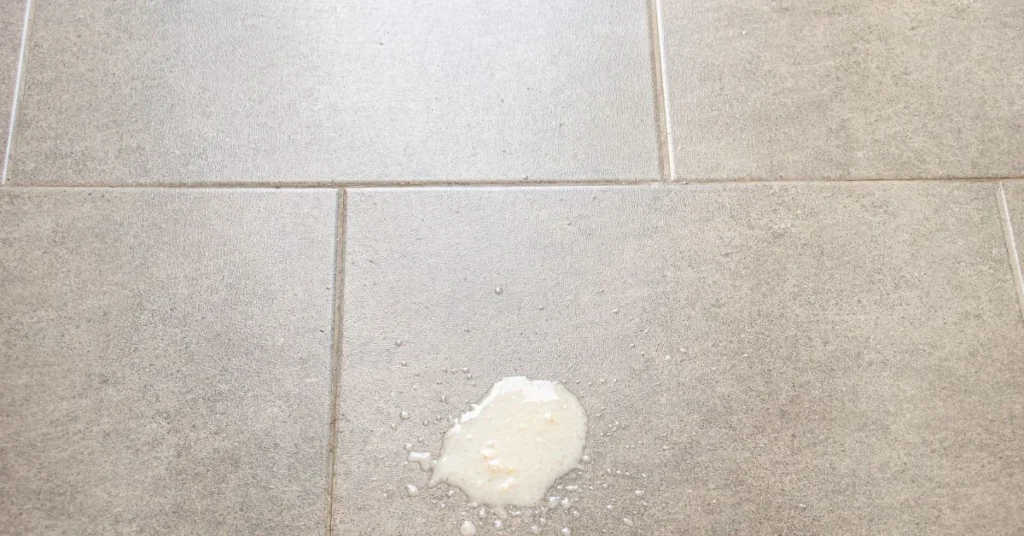Witnessing your cherished pet eject white froth is a terrifying sight. However, you should try to comprehend what this can imply before you freak out. While a dog vomiting white foam may not always indicate a serious health problem, it may be a harmless symptom in certain instances.
Here we’ll go over what might be causing your dog’s health problems, when you should be concerned, and what you can do to help your dog stay safe.
What Does It Mean When a Dog Vomits White Foam?
Saliva and stomach fluids are the common components of white foam vomit. Because of the turbulence in the esophagus and stomach, it frequently looks frothy. Even while it’s scary, it doesn’t necessarily portend a major problem.
But you can’t turn a blind eye to situations that happen repeatedly. The inability to control one’s bowel movements, difficulty breathing, or even an empty stomach can all trigger vomiting.
| Cause | Common Symptoms | Recommended Action |
|---|---|---|
| Empty Stomach / Hunger | Morning vomiting, white foam, normal behavior otherwise | Feed smaller, more frequent meals; monitor |
| Gastrointestinal Upset | Vomiting, slight lethargy, refusal to eat | Withhold food for 12 hours, then offer bland diet |
| Kennel Cough | Coughing followed by white foam, mild lethargy | See vet; may require cough suppressants or antibiotics |
| Acid Reflux | Foamy vomit, especially at night or early morning | Elevate food bowls, feed before bedtime, consult vet |
| Pancreatitis | Vomiting, diarrhea, abdominal pain, lethargy | Seek immediate veterinary care |
| Bloat (GDV) | Restlessness, swollen abdomen, white foam vomiting | Emergency – go to the vet immediately |
| Parvovirus | Foamy vomit, bloody diarrhea, weakness, fever | Urgent vet care; isolate to prevent spread |
| Toxins or Foreign Objects | Vomiting, drooling, unusual behavior, pawing at mouth | Call vet or poison control immediately |
Common Causes of White Foam Vomiting in Dogs
Here are some of the most common reasons a dog may vomit white foam:
1. Empty Stomach or Hunger
- Dogs sometimes vomit bile or white foam when they haven’t eaten for a while.
- This is known as “hunger pukes” and typically occurs in the morning.
2. Gastrointestinal Upset
- Eating grass, spoiled food, or sudden diet changes can irritate the stomach lining.
- Accompanied by mild lethargy or refusal to eat.
3. Kennel Cough
- Similar to a doggy cold, it can cause coughing followed by white foam vomit.
- Often seen in recently boarded dogs or those exposed to other dogs.
4. Acid Reflux (GERD in Dogs)
- Just like humans, dogs can suffer from acid reflux.
- This leads to white or yellowish foam being expelled.
5. Pancreatitis
- A serious inflammation of the pancreas.
- May include symptoms like vomiting, diarrhea, and abdominal pain.
6. Bloat (Gastric Dilatation-Volvulus)
- A life-threatening emergency.
- White foam vomiting is often the first sign, along with restlessness and a distended abdomen.
7. Parvovirus
- Especially in puppies, this virus causes vomiting (often white foam), lethargy, and bloody diarrhea.
- Requires immediate medical care.
8. Ingesting Toxins or Foreign Objects
- Vomiting white foam may follow after eating something toxic or indigestible.
- Symptoms vary but can escalate quickly.

When to See a Vet
Call your vet immediately if your dog is:
- Vomiting repeatedly (more than once in 24 hours)
- Showing signs of pain, bloating, or restlessness
- Lethargic or refusing food and water
- Vomiting white foam with blood or bile
- A puppy or senior with existing health conditions
Diagnosis and Treatment Options
What Your Vet Might Do:
- Physical Exam: Check for bloating, pain, or fever.
- Blood Tests: Rule out pancreatitis or infection.
- X-rays or Ultrasound: To detect obstructions or stomach twisting.
- Stool Samples: To screen for parasites or viruses.
Common Treatments:
- Fasting & Hydration: Temporary food withholding and fluid therapy.
- Medications: Anti-nausea drugs, antacids, or antibiotics.
- Dietary Management: Switching to bland or prescription food.
- Surgery: For obstructions or gastric torsion.
Preventative Measures for Dog Vomiting
Help reduce the chances of your dog vomiting white foam by:
- Feeding smaller, more frequent meals.
- Avoiding abrupt diet changes.
- Preventing access to garbage or non-food items.
- Keeping up with vaccinations and deworming.
- Monitoring stress levels during boarding or travel.
Real-Life Case Study
A Labrador named Lucy, who is three years old, began throwing up white foam every morning. At first, her owner assumed it was just due to hunger. A trip to the vet indicated early pancreatitis following two days of vomiting and weakness. Full recovery was achieved by Lucy with the help of timely fluids and a new low-fat diet.
The moral of the story is that it is crucial to intervene quickly in cases of continuous white foam vomiting.

Conclusion: Dog Vomit
While it’s never fun to see your dog throw up white foam, getting to the bottom of what’s causing it will allow you to respond swiftly. The odd foam vomiting probably isn’t a big deal, but if it happens frequently, you should take your pet to the doctor.
FAQs About Dogs Vomiting White Foam
Why is my dog throwing up white foam but acting normal?
It could be minor — like hunger or mild indigestion. But monitor them closely for changes in behavior or appetite.
Can grass cause my dog to vomit white foam?
Yes, eating grass can irritate the stomach and cause foamy vomit, especially on an empty stomach.
What should I feed my dog after vomiting white foam?
Start with a bland diet like boiled chicken and rice. Gradually reintroduce regular food once they’re stable.
Is white foam vomit dangerous?
Not always — but frequent episodes or combined symptoms (like lethargy or diarrhea) can signal serious conditions.
How can I stop my dog from vomiting foam?
Feed smaller meals more frequently, avoid table scraps, and ensure your dog isn’t ingesting harmful objects.









